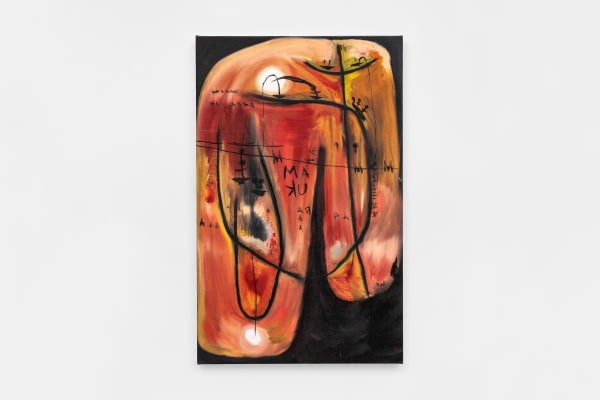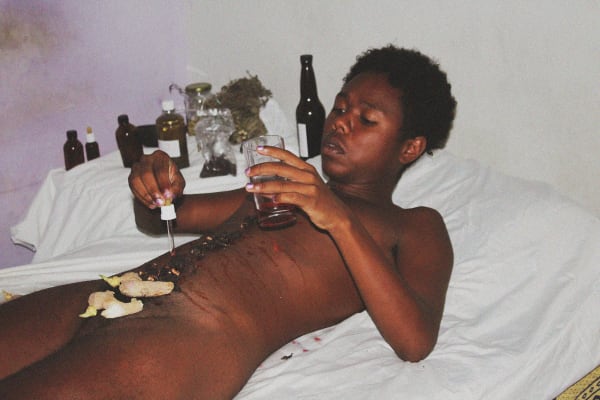Oct 14 - Nov 11, 2022
Mendes Wood DM presents Castiel Vitorino Brasileiro’s solo exhibition Remember when we talked about meeting again—a title which refers to both the start of a conversation and a reminiscence of an essential prophecy. The exhibition gathers photographs, a video work, and oil paintings alongside a site- specific installation of black soil, articulating intangible mysteries and radical materialities to consider themes of metamorphosis and transformative encounters.
The work of Brasileiro intertwines spiritual visions based on Bantu matrices and the black diaspora of Brazil; speculative astrophysics; and her practice as a clinical psychologist. Centered upon the notion of cura as a transitional state of freedom, it is linked with notions of transmutation and hybridism as a true way to health. It embraces the dynamics of movement and mutability as paths towards rethinking the lingering effects of colonization and modernity and its oppressive, inflexible drives. Above all, it unlocks fundamental strategies to forge meaningful connections through spiritual, social, and emotional autonomy.
In the video and photo performances, her body appears in different stages and scenarios, but always engaged in deep vital processes. These magnetic images come to light both as stunning visualities and complex concepts. Working simultaneously as talismans and conceptual tools, these images can influence cognitive shifts, diluting constructed dichotomies related to race, gender, and sexualities, but also echoing interspecies and interplanetary relations, thus tensioning the limits between human and environment, culture and nature, the earthly and the extraterrestrial, the physical and the ethereal.
In Hibisco (2019), the image absorbs us into an intense interior scene, a powerful moment of transmutation, related to an expansive energy field thatconnects the strong physicality we see with an intangible dimension. The large-format photograph shows the artist lying in her grandfather’s bed while he was in hospice care, glass bottles and herbs behind her, enveloped by a purple haze. Dried hibiscus flowers and ginger rest gently on her body while she pours hibiscus tea onto her torso. Brasileiro chose the elements carefully: ginger is known for its cleansing qualities; and in Brazilian-Bantu tradition, hibiscus is utilized as a balancing element. For Brasileiro, this ritual is a path towards spiritual balance with her ancestors, treating bodily traumas, her relationship with her grandfather, and experiences with gender-based violence.
The paintings, drawn from two series of Brasileiro’s works, are imbued with anuncanny language formed by strong fields of color, expressive gestures, and by words and characters from Portuguese, Spanish, English, and Kimbundu along with symbols from Afro-Brazilian culture. Painted in the afternoons while observing the celestial sphere passing through dramatic sunsets, the compositions are linked to investigations of origin, transformation, identity, and expanded notions around the cycle of life. Brasileiro calls upon collective forces, channeling them through her hands and words, focusing on plural manifestations, and the will of the multitudes. As a result, the paintings allow us to see different possibilities for the manifestation of light, gravity and moving masses, in a whirlwind of visceral expressions.
Amidst the paintings, a path of soil weaves through the exhibition space. Standing banners erupt from the path resembling vibrant portals. The organic matter meanders through the gallery, culminating in a lavender sun where it meets the wall. As if consecrated by a ritual, the work exudes an intense energy, serving as groundwork for an accumulation of histories and gestures, enveloping the viewer into a corporal and metaphysical experience.
Works from Brasileiro’s Corpoflor (2016 - ongoing) series work as a dynamic, experimental ontology; an investigation on a flux of memories and affections emerging from the artists’ inner sphere, in which the performativity of the body gives external contours to unnamable internal processes. These self-portraits, thus, are investigations on genders, desires, muscles, fluids, temperatures and all the phenomena going on inside of a body that cannot be fully explained. The two works on view are the latest works in the Corpoflor series realized in Alcântara, Maranhão. A city on Brazil’s northern coast, Alcântara has a complex context marked by a profound ancestral history, a great number of quilombos, impressive colonial ruins and now the site of the Brazilian Space Center and launching facility. Brasileiro appears in Corpoflor adorned with white and black body paint, akin to a living vocabulary astride a motorcycle with an Exú license plate, colorful feathers, and a headdress. The vehicle represents transition and embodies Exú, the Afro Brazilian Orixá commonly associated with streets, crossroads, and which is connected to communication and language, serving as a messenger and mediator between humans and deities. Her body is integrally connected to her environment, to the colorful ornaments, to the automobile, to the artificial light, and to the dark matter of the night.
These works come from a promise the artist made to herself: to continue transmuting, as a kind of radical hybridity, with different lives, realms, and worlds. Every time a Corpoflor appears, it gives birth to a new body, configuration, appearance, and mixture of signs, symbols, colors, and textures—a new way of existing. The artist writes, “Every Corpoflor is a spark coming from inside of me, originated to remind me that I can always assume forms of living not previously envisioned by me or to me. These images are created as a ritual to give me energy to keep wandering in this world of the living and in the world of the dead.”
From spiritual sublimations to the transfiguration of the flesh, the ontology that rises from Castiel Vitorino Brasileiro’s works suggests the coming of a new language, broadening understandings of the nature of life, the human condition, and the agency of the non-human. In her endeavors in the spiral of time, Brasileiro makes contact with earthly and celestial powers, exchanging energies to create truthful unions.
–Germano Dushá
-
 Castiel Vitorino Brasileiro, série A grande onda (The great wave series), 2022
Castiel Vitorino Brasileiro, série A grande onda (The great wave series), 2022 -
 Castiel Vitorino Brasileiro, série A grande onda (The great wave series), 2022
Castiel Vitorino Brasileiro, série A grande onda (The great wave series), 2022 -
 Castiel Vitorino Brasileiro, série A grande onda (The great wave series), 2022
Castiel Vitorino Brasileiro, série A grande onda (The great wave series), 2022 -
 Castiel Vitorino Brasileiro, série A grande onda (The great wave series), 2022
Castiel Vitorino Brasileiro, série A grande onda (The great wave series), 2022 -
 Castiel Vitorino Brasileiro, série A grande onda (The great wave series), 2022
Castiel Vitorino Brasileiro, série A grande onda (The great wave series), 2022 -
 Castiel Vitorino Brasileiro, série A grande onda (The great wave series), 2022
Castiel Vitorino Brasileiro, série A grande onda (The great wave series), 2022 -
 Castiel Vitorino Brasileiro, série my faith unapologetic/ my faith unapologetic series, 2022
Castiel Vitorino Brasileiro, série my faith unapologetic/ my faith unapologetic series, 2022 -
 Castiel Vitorino Brasileiro, série my faith unapologetic/ my faith unapologetic series, 2022
Castiel Vitorino Brasileiro, série my faith unapologetic/ my faith unapologetic series, 2022 -
 Castiel Vitorino Brasileiro, Minha garganta dói, minha garganta pode doer? (My throat hurts, can my throat hurt?), 2019
Castiel Vitorino Brasileiro, Minha garganta dói, minha garganta pode doer? (My throat hurts, can my throat hurt?), 2019 -
 Castiel Vitorino Brasileiro, Alcântara 2 (série Corpoflor), 2016 - present, 2022
Castiel Vitorino Brasileiro, Alcântara 2 (série Corpoflor), 2016 - present, 2022 -
 Castiel Vitorino Brasileiro, Hibisco (Hibiscus), 2019
Castiel Vitorino Brasileiro, Hibisco (Hibiscus), 2019 -
 Castiel Vitorino Brasileiro, Sem título (série Corpoflor), 2016-presente, 2020
Castiel Vitorino Brasileiro, Sem título (série Corpoflor), 2016-presente, 2020 -
 Castiel Vitorino Brasileiro, Me faça um pedido (Make me a wish), 2021
Castiel Vitorino Brasileiro, Me faça um pedido (Make me a wish), 2021














